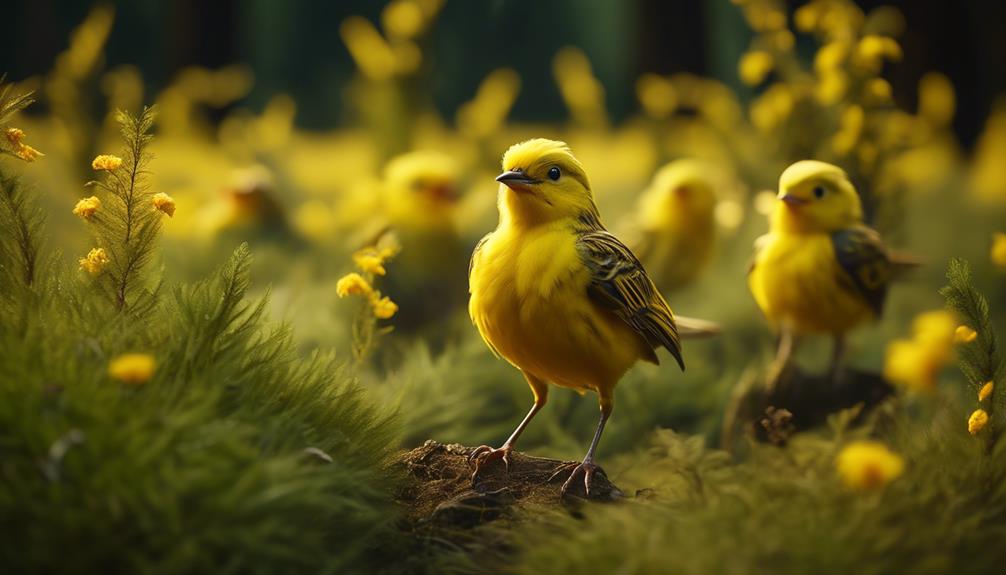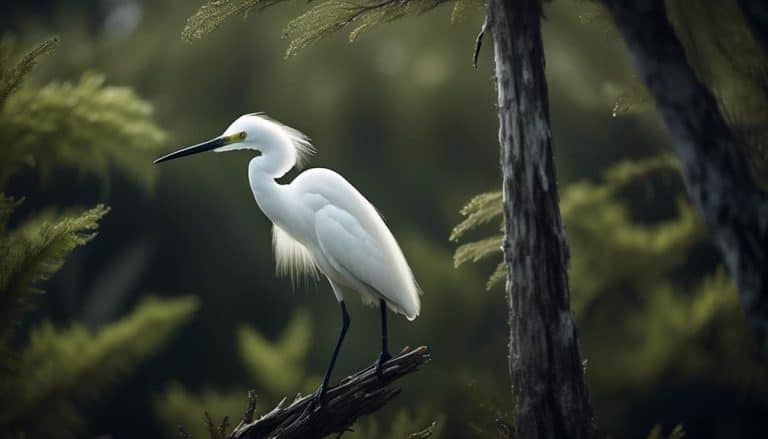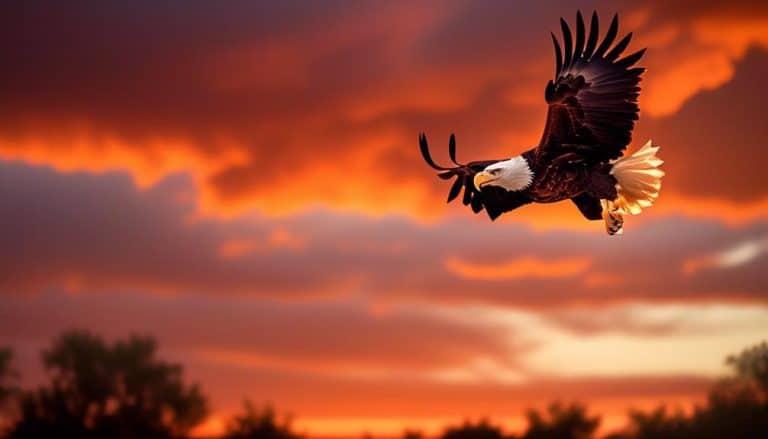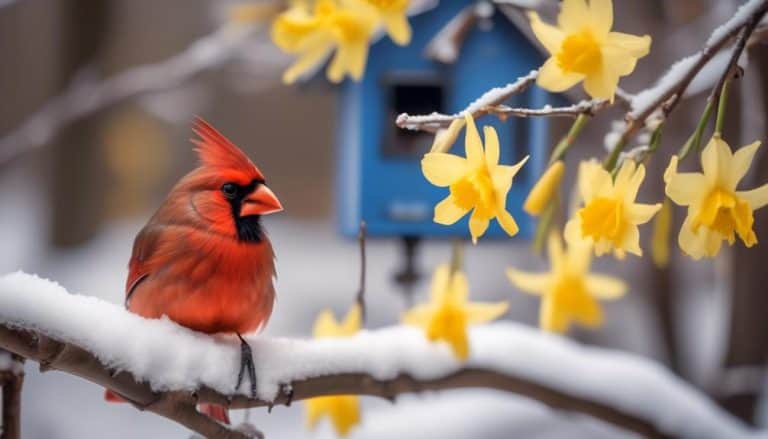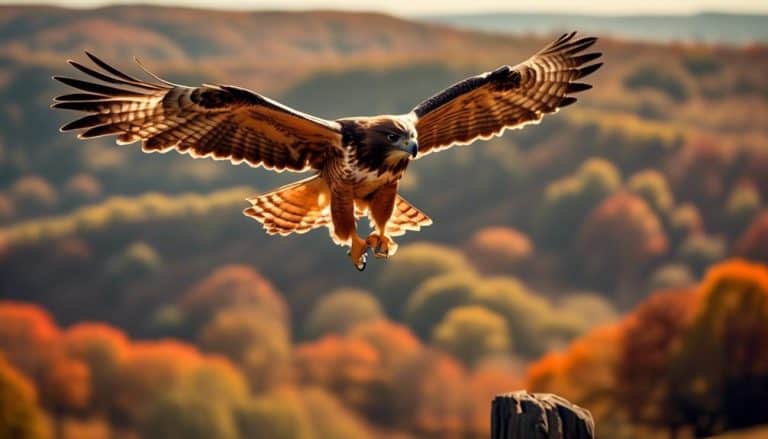As I stood on the shores of Oregon's rugged coastline, a vibrant flash of yellow caught my eye. It was a solitary yellow bird, soaring gracefully above the crashing waves, its golden plumage shining in the sunlight.
This encounter sparked my curiosity about the diverse species of yellow birds that call Oregon home. From the coastal areas to the lush forests and majestic mountains, there is a rich tapestry of yellow feathered creatures waiting to be discovered.
Join me on a journey as we explore the fascinating world of yellow birds in Oregon, uncovering their unique characteristics, their habitats, and the best spots to catch a glimpse of these elusive creatures.
Common Yellow Bird Species in Oregon
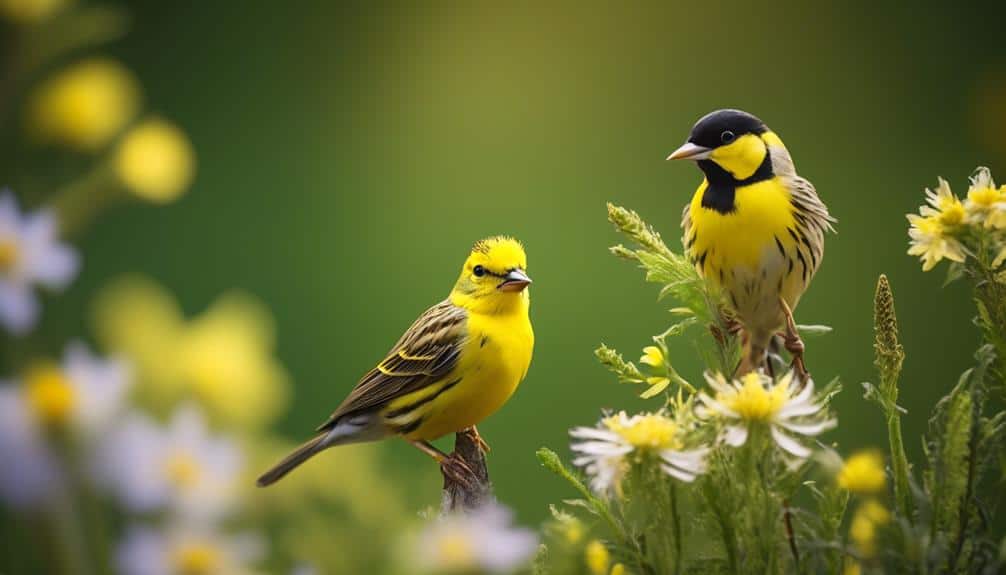
I have observed several common yellow bird species in Oregon during my field research, including the American Goldfinch, Wilson's Warbler, and the Yellow Warbler. These birds exhibit distinct migration patterns in the region, which are influenced by various factors, including the impact of climate change.
The American Goldfinch, also known as Spinus tristis, is a migratory bird that breeds in Oregon during the summer months. It's characterized by its bright yellow plumage and distinctive black wings with white wing-bars. This species undergoes a relatively short migration, traveling south to warmer regions in the winter, such as California and Mexico.
Similarly, the Wilson's Warbler, or Cardellina pusilla, is a yellow bird species that migrates through Oregon during spring and fall. It's known for its vibrant yellow color, black cap, and olive-green back. These birds breed in the northern parts of North America and spend their winter in Central and South America.
The Yellow Warbler, scientifically known as Setophaga petechia, is another common yellow bird species in Oregon. It has a bright yellow body with reddish streaks on its chest. These birds follow a long-distance migration route, traveling from their breeding grounds in North America to their wintering grounds in Central and South America.
The migration patterns of these yellow bird species in Oregon are crucial for their survival and reproduction. However, climate change poses a significant threat to their populations. Rising temperatures and changing weather patterns can disrupt their migratory routes, alter their breeding habitats, and affect their food availability. These changes can have adverse effects on the overall population size and distribution of these yellow bird species in Oregon.
Unique Yellow Birds Found in Coastal Areas
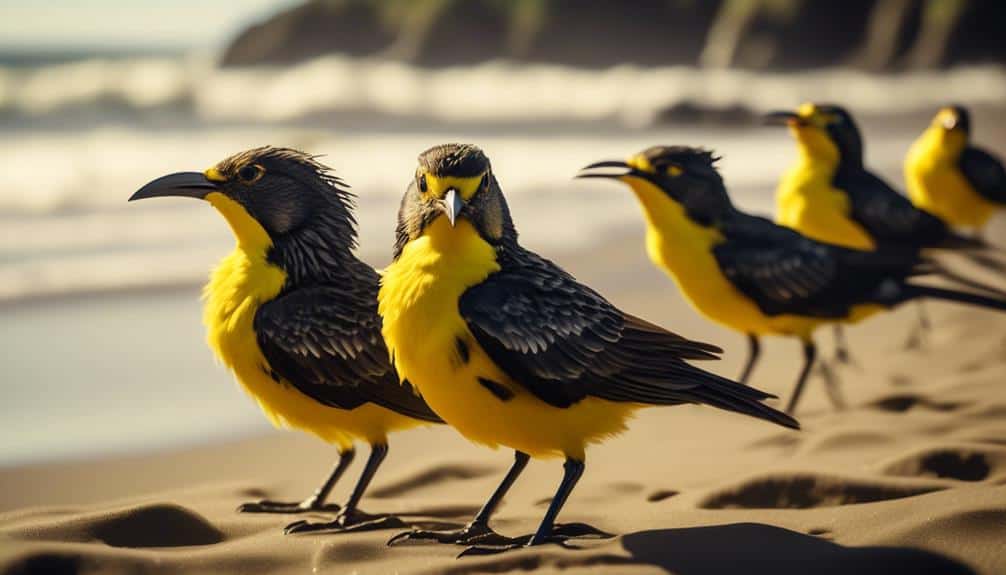
The coastal areas of Oregon are home to several unique yellow bird species, adding to the diversity and beauty of the region's avian population. These birds not only serve as visual delights but also play important ecological roles.
Here are five remarkable yellow bird species found in Oregon's coastal areas:
- Western Tanager: This vibrant yellow bird is known for its black wings and reddish head. It has a wide range and can be spotted in forests and woodlands. The Western Tanager migrates between its breeding grounds in the western United States and its wintering grounds in Mexico and Central America.
- Yellow Warbler: With its bright yellow plumage and sweet song, the Yellow Warbler is a common sight along streams and wetlands. These birds have impressive migratory abilities, traveling long distances from their breeding grounds in North America to their wintering habitats in South America.
- American Goldfinch: Found in open fields and meadows, the American Goldfinch is known for its bright yellow feathers and distinctive flight pattern. These birds play an essential role in pollination, as they feed on the seeds of various flowering plants and disperse them through their droppings.
- Yellow-rumped Warbler: As its name suggests, this bird has a yellow rump, as well as a yellow throat and sides. It's an adaptable species that can be found in a range of habitats, including forests and shrublands. During migration, these warblers can cover vast distances, traveling from their breeding grounds in North America to their wintering areas in Mexico and Central America.
- Wilson's Warbler: This small, yellow bird is known for its distinctive black cap. It can be found in dense vegetation along streams and wetlands. Wilson's Warbler is an important pollinator, as it feeds on nectar and insects, inadvertently transferring pollen from flower to flower.
These unique yellow bird species not only contribute to the visual splendor of Oregon's coastal areas but also play vital roles in pollination and seed dispersal, highlighting their ecological significance.
Yellow Birds of Oregon's Forests and Mountains
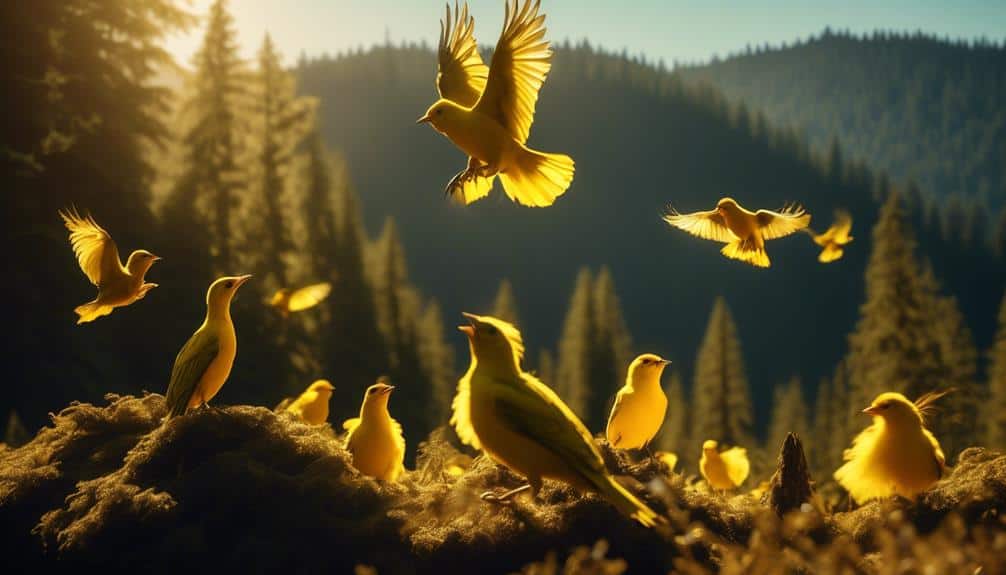
Yellow bird species found in Oregon's forests and mountains exhibit unique adaptations to thrive in these diverse ecosystems. These birds have evolved specific characteristics that allow them to navigate the varied terrain and find food sources in their habitats. Here, I will discuss the yellow bird migration patterns and feeding habits observed in Oregon's forests and mountains.
| Yellow Bird Species | Migration Patterns | Feeding Habits |
|---|---|---|
| Western Tanager | Migratory | Insectivorous |
| American Goldfinch | Partial Migrant | Seed Eaters |
| Yellow Warbler | Migratory | Insectivorous |
| Bullock's Oriole | Migratory | Nectar Eaters |
Yellow birds, such as the Western Tanager and Yellow Warbler, migrate annually to and from Oregon's forests and mountains. These birds travel long distances to reach their breeding grounds during the summer months, where they find abundant insect populations for feeding. During migration, they rely on their keen sense of navigation and visual cues to follow specific routes.
Feeding habits vary among yellow bird species. American Goldfinches primarily feed on seeds, while Bullock's Orioles are known to be nectar eaters. This diversity in feeding habits allows yellow birds to utilize different food resources available in Oregon's forests and mountains.
Understanding the migration patterns and feeding habits of yellow birds in Oregon's forests and mountains is crucial for conservation efforts. By protecting their habitats and ensuring the availability of food sources, we can help these unique and vibrant birds thrive in their natural ecosystems.
Rare and Endangered Yellow Bird Species
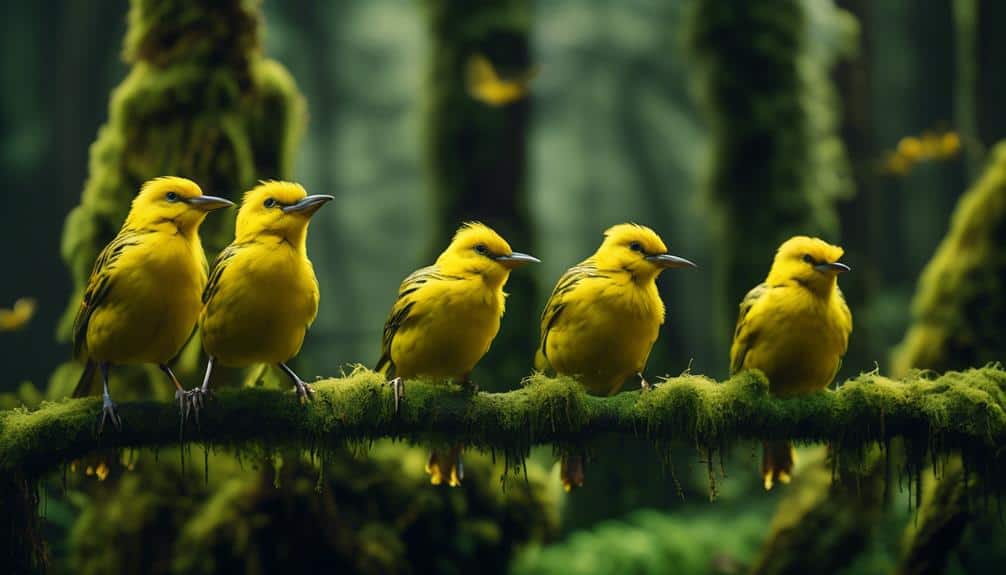
As we shift our focus to the conservation of Oregon's forests and mountains, it's essential to address the plight of certain yellow bird species that are rare and endangered. These birds face numerous challenges, primarily due to habitat destruction caused by human activities.
To engage the audience, let's explore some key aspects of these endangered yellow bird species:
- Conservation efforts: Various organizations and agencies are working tirelessly to protect and conserve the habitats of these rare yellow bird species. These efforts include habitat restoration, monitoring populations, and implementing conservation plans.
- Habitat destruction: The primary threat to these endangered yellow birds is habitat destruction. Human activities like deforestation, urbanization, and agricultural expansion result in the loss and fragmentation of their natural habitats. Such loss severely impacts their breeding, foraging, and nesting behaviors.
- Endangered status: Some of the rare and endangered yellow bird species found in Oregon include the Yellow-billed Cuckoo, Western Bluebird, and Townsend's Warbler. These species have experienced declining populations and are listed as endangered or threatened under the Endangered Species Act.
- Importance of biodiversity: Protecting these yellow bird species is crucial for maintaining biodiversity in Oregon's ecosystems. They play vital roles as pollinators and seed dispersers, contributing to the overall health and functioning of the ecosystem.
- Collaborative approach: Conservation efforts require collaboration between scientists, policymakers, landowners, and the general public. By raising awareness and actively participating in conservation initiatives, we can ensure the survival of these rare and endangered yellow bird species for future generations.
Best Birdwatching Spots for Yellow Birds in Oregon
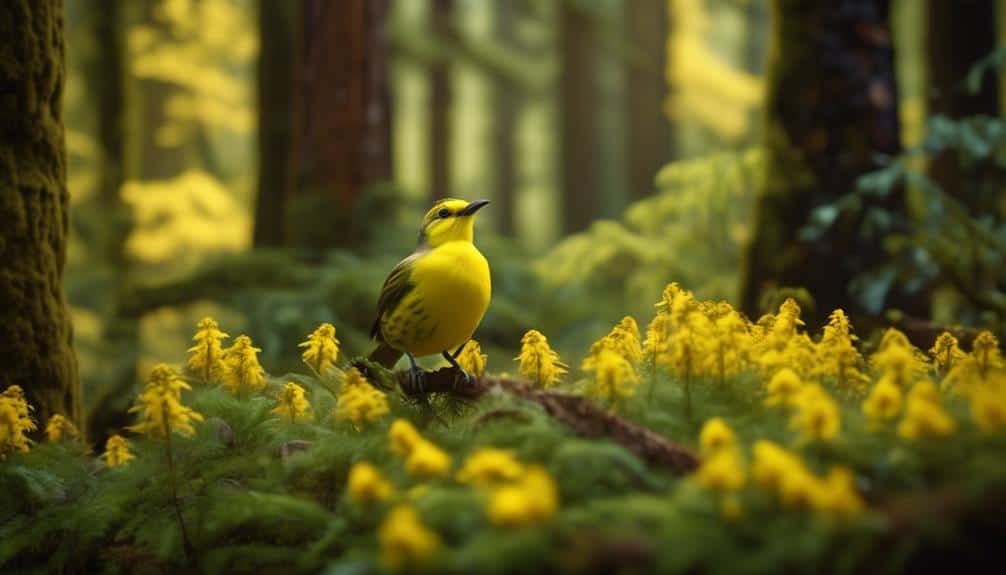
Nestled within the diverse landscapes of Oregon, prime birdwatching spots await avid enthusiasts seeking to catch a glimpse of the vibrant yellow feathers adorning rare and endangered species. Oregon's unique geographical location makes it an important stopover for yellow birds during their migration patterns. Whether you are a seasoned birdwatcher or a beginner, having the right equipment can greatly enhance your chances of spotting these magnificent creatures.
To assist you in your birdwatching endeavors, here are some of the best spots in Oregon known for their yellow bird populations:
| Spot | Location | Best Time to Visit |
|---|---|---|
| Malheur National | Southeastern Oregon | Spring and Fall |
| Wildlife Refuge | ||
| Powell Butte Nature | Portland, Oregon | Summer and Winter |
| Park | ||
| Baskett Slough | Willamette Valley, Oregon | Winter and Spring |
| National Wildlife | ||
| Refuge | ||
| Fernhill Wetlands | Forest Grove, Oregon | Year-round |
Yellow bird migration patterns indicate that spring and fall are the ideal seasons to witness their breathtaking journeys. During these times, the influx of migratory birds creates a spectacle of colors and sounds. To maximize your chances of spotting yellow birds, it is recommended to use binoculars with a high magnification power and a field guide specific to the region. Additionally, wearing camouflage clothing and remaining patient and quiet will help you blend into the surroundings and observe these magnificent creatures without disturbing them.
Frequently Asked Questions
How Do Yellow Birds Contribute to the Ecosystem in Oregon?
Yellow birds contribute to the ecosystem in Oregon by their diet, which includes insects and seeds, helping to control pest populations and disperse seeds. Their nesting habits provide shelter for other bird species, promoting biodiversity.
Are Yellow Birds in Oregon Known to Migrate?
Yes, yellow birds in Oregon are known to migrate. They travel long distances to find suitable habitats and can be spotted during their migratory journey. Yellow bird sightings are a fascinating spectacle for bird enthusiasts.
What Is the Average Lifespan of Yellow Birds Found in Coastal Areas?
The average lifespan of yellow birds found in coastal areas can vary depending on various factors such as habitat conditions and predation rates. It is important to consider these factors when discussing the average lifespan of these birds.
Are There Any Specific Threats or Challenges Facing Yellow Birds in Oregon's Forests and Mountains?
There are several threats and challenges that yellow birds face in Oregon's forests and mountains. These include habitat loss, predation, climate change, and competition for resources. These factors can have a significant impact on the population and survival of yellow birds.
Are There Any Ongoing Conservation Efforts to Protect Rare and Endangered Yellow Bird Species in Oregon?
There are ongoing conservation efforts to protect rare and endangered yellow bird species in Oregon. These efforts focus on preserving their habitats, implementing breeding programs, and monitoring their populations to ensure their survival.
Conclusion
After exploring the diverse habitats of Oregon, it's clear that the state is a haven for yellow bird species. From the coastal areas to the forests and mountains, these bright and beautiful birds can be found in abundance.
However, it's important to note the presence of rare and endangered yellow bird species, reminding us of the need for conservation efforts.
Birdwatchers should flock to Oregon's best spots to witness the vibrant yellow plumage of these avian wonders. Don't miss out on this golden opportunity!

